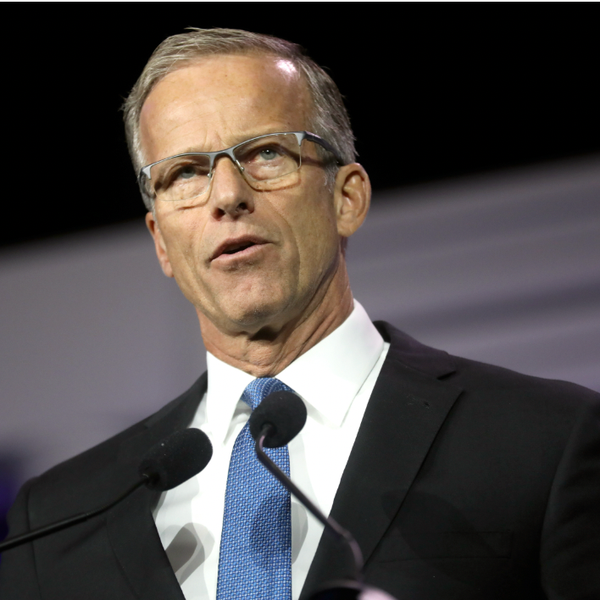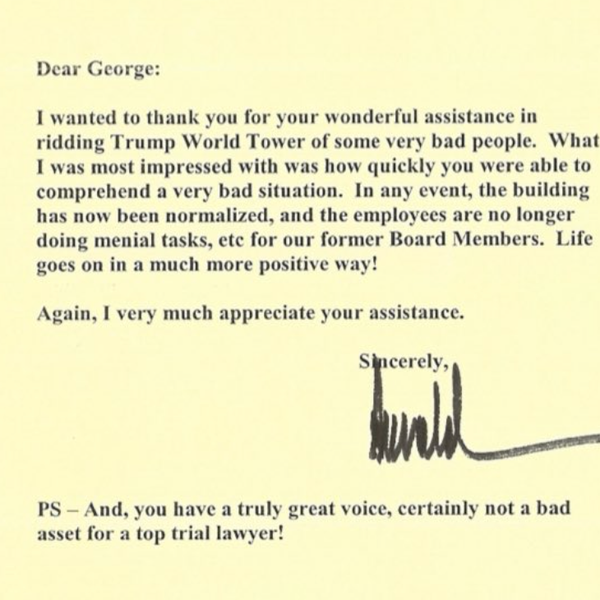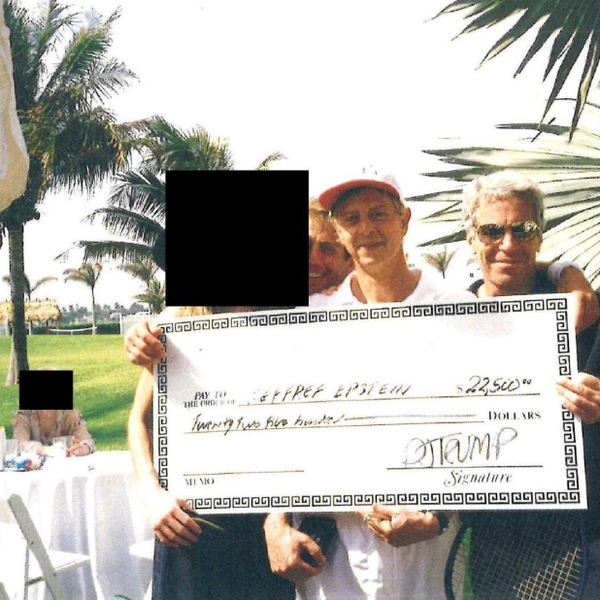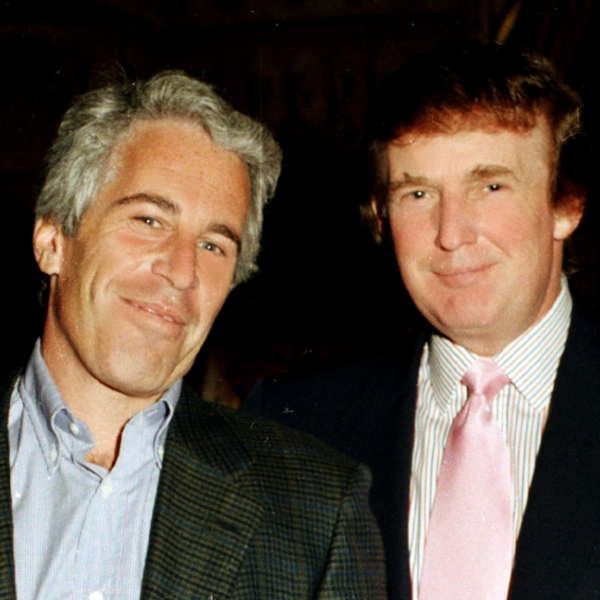Uh Oh: Big Baby With Scary Big Toy Will Bomb-Bomb-Bomb Iran
Time-travel with me now, if you will, to the year 2002. I guess you could describe it as a “while the world slept” moment on December 12 of that year when CNN reported, “U.S. troops get in place in the Gulf.” The report ticked off the steps that were already being taken: Central Command leader Gen. Tommy Franks moved to the As Saliyah base in Qatar. He airlifted into place a modular command and control headquarters. Remember the briefing room with the three flat-screen TV’s that looked so sexy when the invasion began in March? That was part of the modular command center.
Three thousand troops were already in place in Qatar. The Third Infantry Division, about 30,000 strong, was conveniently “training” in Kuwait. In January, the first 25,000 combat troops in the U.S. began their mass movement to Kuwait.
I’m taking the time to remind you of that ignominious time in our not-too-distant past because another version of that sort of build-up is already underway in Europe and the Middle East. Over the weekend, Secretary of Defense Pete Hegseth moved three dozen U.S. tanker aircraft to bases in Spain, Germany, and the United Kingdom The tankers are used to refuel U.S. fighter jets and bombers, and can also be used to refuel Israeli aircraft. There have now been reports that military assets – we don’t know exactly what they are, but they could be aircraft, troops, vessels, tanks, and other heavy equipment – have been “deployed” to the Middle East.
On March 17, 2003, President George Bush, in a televised address to the nation, demanded that Saddam Hussein and his two sons, Uday and Qusay “surrender” and leave Iraq. He gave them a 48-hour deadline.
Today, in a modern twist on the dusty old tradition of a presidential address from the Oval Office, Trump took to his Truth Social account and threatened the life of Iran’s Supreme Leader, Ayatollah Ali Khamenei. “We know exactly where the so-called ‘Supreme Leader’ is hiding. He is an easy target, but is safe there – We are not going to take him out (kill!), at least not for now,” Trump posted. “But we don’t want missiles shot at civilians, or American soldiers. Our patience is wearing thin. UNCONDITIONAL SURRENDER.”
Is any of this starting to seem familiar? Imaginary threatened Iranian missiles that will be “shot” at “American soldiers?” Where, may I ask, are these American soldiers that Iranian missiles might be fired at? One of the general MSM round-up stories this afternoon casually said the U.S. already has 40,000 soldiers in the Middle East, without identifying their locations. I would guess Qatar, Kuwait, Iraq, probably a few still in Syria, and I’m sure we’ve got some in Egypt and scattered around on small bases elsewhere.
Hey, we put them there, right? Iran is pissed off enough that they are rocketing Israel and sending armed attack drones. If they get pissed off at us, they’ll be firing at U.S. targets, which would logically include American military bases, including air force and naval stations, and Army bases that have been in Kuwait since…you guessed it…since we liberated that country from Iraqi occupation with Operation Desert Storm in 1991.
Are you detecting a trend here? The U.S. supplies Israel with about $3 billion a year in military hardware and other aid with basically no limits on how it should be used. Trump has been engaged in alleged “negotiations” with Iran over its nuclear program – which are necessary only because he cancelled the treaty that was already in place.
Trump’s negotiator is a New York real estate guy he’s friendly with, Steve Witkoff, who has owned inexpensive buildings in lower Manhattan, Washington Heights, and the Bronx through a firm called Stellar Management. He also owns commercial property and hotels like the Park Lane and high rise apartment buildings in Tribeca and Philadelphia, Chicago, and Dallas. So Iranian negotiators, who are not dummies, know that they are sitting down to discuss the future of their nuclear program with a guy who oversees the installations of new toilets in apartments and supervises the changing of sheets and swabbing out bathrooms at hotels.
At least when Bush was threatening Saddam Hussein, he was sending people like Colin Powell to the U.N. and he had a Secretary of Defense, Donald Rumsfeld, who was serving in that job a second time. Rumsfeld was an asshole, but at least he wasn’t a sexual abuser tattooed cartoon like Hegseth who challenges troops to pushup contests to show them how macho he is.
But why am I even talking about Hegseth? It doesn’t matter that Trump has a real estate buddy he met in a deli in New York negotiating for him, and a Secretary of Defense who has paid off a woman to keep her mouth shut about the night he sexually assaulted her in a hotel room. It doesn’t even matter that his secretary of state is a man he once called “Little Marco” to his face on national television.
The only one who matters is Donald Trump, and he's having so much fun, he can barely stand it. He’s bubbling over threatening Iranians and making demands. He is so blasé about Israel’s attacks on Iran and the issue behind them, nuclear weapons, Trump even took the time last night to angrily tell reporters that he’s not going to call Minnesota Governor Tim Walz about the Democratic members of the state House and Senate who were killed and wounded by one of his supporters. Why isn’t it important to call Tim Walz? Because according to Trump, Walz is “slick” and “whacked out.”
“Why would I call him?” Trump said on Air Force One, on his way back to the White House so he could meet with his highly qualified national security team this afternoon in the Situation Room. “The guy doesn’t have a clue. He’s a, he’s a mess. Why waste time?”
Trump clearly thinks the people on the other end of his negotiations over nuclear weapons don’t follow the news in the United States, and don’t have anyone studying the person with whom, ultimately, they are dealing.
Oh, damn, I’m doing it again. I’m comparing the situation with Donald Trump getting ready to attack Iran with people who, while they made some terrible decisions based on some terrible information about Iraq, were at least fucking sane.
See, that’s the problem we’re having. It’s almost impossible to cover what’s going on – which is that we are apparently preparing to start a war with Iran – without involuntarily sanewashing the madman who’s making the decisions. That’s what it’s called, sanewashing, a whole word they came up with just to deal with Donald Trump.
We can’t treat this man as if he is a rational actor. A rational human being, a man with actual human feelings, would not call the governor of Minnesota childish names right after his state has had two of its political figures shot by someone who had a list of 45 more Democrats he wanted to assassinate. A rational actor would not post on a social media platform a demand that the leader of a country with which we are not at war -- yet – unconditionally surrender.
To whom? is the question that should be asked. Why would the Supreme Leader of Iran surrender to Donald Trump when the U.S. hasn’t fired a single bullet at them or dropped a single bomb. The Congress hasn’t declared war or even passed one of those lame-ass “authorization of use of force” thingees.
The answer is as obvious as the depressed look on Trump’s face watching his big military parade pass his reviewing stand on Saturday, and it was occurring to him that his big celebration of self wasn’t going at all the way he had planned. The soldiers in the tanks were waving to girls in the stands. The marching formations were out of step, looking like they hadn’t taken the whole thing seriously enough to practice marching. The crowds looked like tourists out for the afternoon in Washington D.C. with nothing else to do. The bleachers weren’t even half full. Everybody watching on TV could see the whole thing was a bust. And elsewhere, on the phone ever-present in his pocket, Trump could see that the rest of the country was in the streets, millions of them, having the time of their lives telling him to go fuck himself.
The Iranians had to be watching all this on television and going oh shit as the second night of Israeli rockets hit them. Look at Trump’s face. He is not happy. That is not good for us.
So here we are, dear readers, after the weekend that Donald Trump saw how enormous his opposition is, and how organized, and how peaceful, for crying out loud. He’s mad as hell, and as luck would have it, he has a way to show it. He can drop the world’s biggest bomb that isn’t a nuke on Iran, and nobody can stop him. All the libs, all the newspaper editorial pages, all his MAGA allies who are beginning to understand the truth about “American First.” It means, as ever, Trump first.
All those guns on those tanks on Saturday weren’t loaded, but goddamn it, he can order up some B-2 bombers and load them up with some Massive Ordnance Penetrator bombs, and he’ll show them!
We can come right out and admit it: We have a big, angry child in the White House, and he’s throwing a tantrum, and the only thing that will make him happy is starting a war in the Middle East.
Man, are we in for it.
Lucian K. Truscott IV, a graduate of West Point, has had a 50-year career as a journalist, novelist, and screenwriter. He has covered Watergate, the Stonewall riots, and wars in Lebanon, Iraq, and Afghanistan. He is also the author of five bestselling novels. He writes every day at luciantruscott.substack.com and you can follow him on Bluesky @lktiv.bsky.social and on Facebook at Lucian K. Truscott IV. Please consider subscribing to his Substack.
Reprinted with permission from Lucian Truscott Newsletter.












